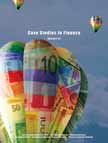Sumitomo Corporation of Japan - The Commodity Derivatives Fiasco
|
|
ICMR HOME | Case Studies Collection
Case Details:
Case Code : FINC029
Case Length : 13 Pages
Period : 1996 - 2004
Pub. Date : 2004
Teaching Note :Not Available
Organization : Sumitomo Corporation
Industry : Financial Trading, Minerals
Countries : Japan
To download Sumitomo Corporation of Japan - The Commodity Derivatives Fiasco case study (Case Code:
FINC029) click on the button below, and select the case from the list of available cases:

Price:
For delivery in electronic format: Rs. 400;
For delivery through courier (within India): Rs. 400 + Shipping & Handling Charges extra
» Finance Case
Studies
» Short Case Studies
» View Detailed Pricing Info
» How To Order This Case
» Business Case Studies
» Case Studies by Area
» Case Studies by Industry
» Case Studies by Company

Please note:
This case study was compiled from published sources, and is intended to be used as a basis for class discussion. It is not intended to illustrate either effective or ineffective handling of a management situation. Nor is it a primary information source.
Chat with us

Please leave your feedback

|
|




<< Previous
"At fault may be a global business culture that lavishly rewards traders who take risks but not the people who are supposed to supervise them." 1
- - David Hale, Economist, Zurich Kemper Investments.
"The moral fiber of all Japanese has deteriorated and they have become desensitized toward money." 2
- Seiroku Kajiyama, Chief Cabinet Secretary, Japan.
Introduction
On June 13, 1996, Sumitomo Corporation (Sumitomo)3 - one of the largest trading companies in Japan, reported a loss of $1.8 billion (bn) in copper trading on the London Metal Exchange (LME).4
|
The loss was the result of trading operations in commodity derivatives by Yasuo Hamanaka (Hamanaka), Sumitomo's former chief copper trader. Elaborating on the reasons for the loss incurred by the company, Tomiichi Akiyama (Akiyama), the then president of Sumitomo said, "These transactions were made solely by Yasuo Hamanaka himself. Hamanaka abused Sumitomo's name, and continued on with such unauthorized trading."5 Sumitomo was the largest participant in the physical market6 for copper, its volume being twice that of the second largest participant. The loss reported by Sumitomo was the largest unauthorized trading-related loss incurred by any Japanese company during that time.
|

|
This financial debacle occurred at a time when the world's financial markets were yet to recover from two major financial debacles - the collapse of UK's 233-year-old Barings Bank, which lost $ 1.4 bn in February 1995 due to Nick Leeson's unauthorized trading activities in the Singapore futures market and the Japanese bank Daiwa which lost $1.1 bn in America's Treasury bond market in September 1995 due to the unauthorized trading activities of Toshihide Iguchi, a New York based trader.
|
|
All the three debacles happened within a short span of 16 months. Industry analysts and the media were quick to comment that the trading in commodities and financial instruments was not being properly monitored by the government regulatory agencies and by the companies undertaking these transactions. Ota Rie of ING Barings in Tokyo said, "What Sumitomo did with this man was very unusual. It is rare to see a middle-level manager get so much power."7 Experts said that the situation demanded tighter internal supervision and control procedures by trading firms and financial institutions the world over. Kenichi Yoshida, an analyst at Nikko Research Centre said, "Hamanaka was famous because of the business he brought in... |
Sumitomo Corporation of Japan - The Commodity Derivatives Fiasco
- Next Page>>
|
|









